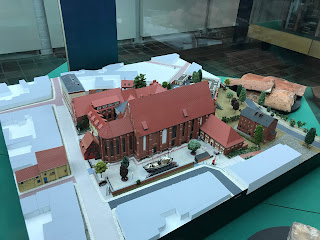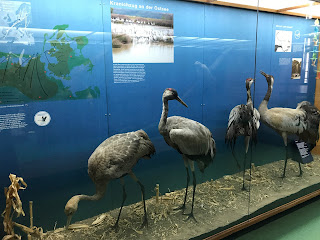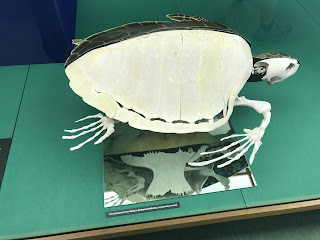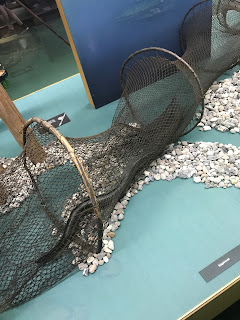Es ist November 2021, ich bin in Stralsund und spaziere durch die Altstadt bei leichtem Nieselregen und suche eine Teststelle, damit ich, ausgestattet mit einem negativen Coronatest, ein Café besuchen, um Kuchen zu essen. Hat nicht geklappt. Allerdings wohne ich in einem sehr komfortablen Apartment und kaufe mir Kuchen, den ich dann einfach dort essen kann, da kann ich auch gleich mehr als ein Stück nehmen. Praktisch.
Auf meinem Streifzug streife ich auch die ehemalige Katharinenkirche, sie beherbergt das Meereskundemuseum, welches im Moment geschlossen ist, da alles renoviert wird. Aber das macht nichts, ich war dort schon mal und möchte es weiter empfehlen. Es ist großartig. Wie alle Museen, die ich in Stralsund besucht habe. Eigentlich war ich schon zweimal da, einmal in den 70ern als Kind während der Sommerferien, ein Ausflug vom Ferienlager, aber ich erinnere mich nicht mehr an vieles, nur an das Skelett des großen Wal.
Das Museum vereint die gotische Architektur der ehemaligen Klosterkirche mit Exponaten von Meeresbewohnern und Schiffen und großen und kleinen Aquarien, in denen Fische, Korallen und Schildkröten in einen nachgebauten natürlichen Habitat betrachtet, beobachtet werden können.
Die Halle der alten Kirche ist gerade groß genug, um die Skelette von Walen aufnehmen zu können und macht deutlich, wie klein der Mensch ist, im Gegensatz zu vielen anderen Lebewesen und wie groß, der Schaden ist, den er anzurichten in der Lage ist. Das Thema des Umweltschutzes im Meer und an der Küste ist ein zentrales Anliegen des Museums, ähnlich, wie ich es auch im Ozeaneum gesehen habe (https://fraumb-far-far-away.blogspot.com/2016/10/unter-dem-meer-ozeaneum-stralsund-under.html?m=1).
Ein großer Teil der Ausstellungen befasst sich mit dem Meer als Wirtschaftsgebiet, mit der Fischerei und dass der Fisch neben der Nahrung auch ein Rohstoff für viele Produkte war, zum Teil heute noch ist, und dass wir ihn zum Verschwinden bringen können, wenn wir ihn ausschließen als Nahrung und Rohstoff sehen, und was zu tun ist, um das zu verhindern.
Auch hier gibt es viele Dioramen und Schaukästen und es ist alles mit sehr viel Liebe zum Detail, viel Sachkenntnis und aus verschiedenen Blickwinkeln gestaltet. Auch das Aquarium im Keller, viel kleiner als das am Hafen, gefiel mir gut und der große Tank mit den Schildkröten. Nun muss ich noch ein drittes Mal hin, wenn die Renovierung abgeschlossen ist, denn aller guten Dinge sind drei.
Und, wenn man schon mal am alten Kloster ist, es gibt dort noch ein tolles Museum, das Stralsund Museum (https://fraumb-far-far-away.blogspot.com/2016/10/im-katharinenkloster-stralsund-museum.html?m=1).
English version below
It’s November 2021, I’m in Stralsund strolling around the historic city centre in light rainfall and are searching for a Covid test station to get me a kind of ticket to enter a coffeehouse, but I failed. On the other hand, I’m lodging in a very nice apartment and I just buy me some cake, more than I would have ordered in the café and go home. Lovely.
During my walk-around I pass along the old Katarine Church that houses now the Oceanographic Museum. It’s currently closed for renovations, but I’ve been here already twice, once as a kid, when me made a day trip from the summer camp, and I can’t remember much but the skeleton of the big whale and the second time a couple of years ago. I liked it very much and would like to recommend it to my dear readers.
The museum connects the gothic architecture of the former cloister church with exhibits of nautical creatures and ships, aquariums and tanks for small fishes, corals and sea turtles.
The hall of the former church is just big enough to give space for the skeletons of whales and shows how tiny humans are in the presence of many other living beings and how huge the damage is that men are doing to their living space and to them. The topic of protection of the environment in the ocean and the shores is the central statement of the exhibition, like I saw it already in the Ozeaneum (https://fraumb-far-far-away.blogspot.com/2016/10/unter-dem-meer-ozeaneum-stralsund-under.html?m=1).
A big part of the exhibition is dedicated to the sea a an economical source and shows that fish is not only food for us humans but was a primary commodity for many products we used and still do, and that we will make them vanish when we only see them as food and resources and what could and must be done to avoid this.
Here too are any diorama and show boxes, designed with much love for details, lot of knowledge and a view from different angles. The aquariums are smaller than the one at the port and I liked the tank with the turtles. Now I need to go a third time, but all good things are three.
And if you are already at the former cloister, don’t miss the Stralsund Museum what is displayed in the next building (https://fraumb-far-far-away.blogspot.com/2016/10/im-katharinenkloster-stralsund-museum.html?m=1).



















































Keine Kommentare:
Kommentar veröffentlichen